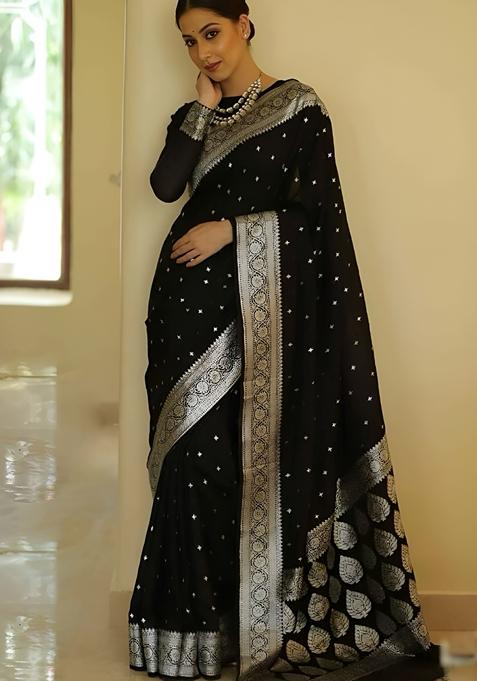- Categories
- Colour
- Discount
- Fabric
- Occasion
- Pattern
- Size
- Price
-
 76%
76%
OFFPRE STITCHED AVAILABLE
Sizes XS,S,M,L,XL,2XL,3XL,4XL,5XL,6XL,7XL,8XL,Unstitched
Black Jacquard Banarasi Soft Silk Saree Set
10 Day Delivery -
 82%
82%
OFFPRE STITCHED AVAILABLE
Sizes XS,S,M,L,XL,2XL,Unstitched
Maroon Weaving Silk Saree Set
10 Day Delivery -
 76%
76%
OFFPRE STITCHED AVAILABLE
Sizes XS,S,M,L,XL,2XL,Unstitched
Onion Pink Weaving Silk Saree Set
10 Day Delivery -
 76%
76%
OFFPRE STITCHED AVAILABLE
Sizes XS,S,M,L,XL,2XL,3XL,4XL,5XL,6XL,7XL,8XL,Unstitched
Beige Digital Print Cotton Linen Saree Set
10 Day Delivery -
 76%
76%
OFFPRE STITCHED AVAILABLE
Sizes XS,S,M,L,XL,2XL,3XL,4XL,5XL,6XL,7XL,8XL,Unstitched
Green Weaving Khadi Cotton Saree Set
10 Day Delivery -
 76%
76%
OFFTRENDING
PRE STITCHED AVAILABLE
Sizes XS,S,M,L,XL,2XL,3XL,4XL,5XL,6XL,7XL,8XL,Unstitched
Multicolor Ombre Pattern Mul Chanderi Linen Cotton Saree Set
10 Day Delivery -
 76%
76%
OFFPRE STITCHED AVAILABLE
Sizes XS,S,M,L,XL,2XL,3XL,4XL,5XL,6XL,7XL,8XL,Unstitched
White Weaving Silk Saree Set
10 Day Delivery -
 76%
76%
OFFPRE STITCHED AVAILABLE
Sizes XS,S,M,L,XL,2XL,3XL,4XL,5XL,6XL,7XL,8XL,Unstitched
Orange And Pink Bandhani Print Chiffon Saree Set
10 Day Delivery -
 71%
71%
OFFPRE STITCHED AVAILABLE
Sizes XS,S,M,L,XL,2XL
Mauve Embroidered Gold Crush Tissue Silk Pre-Stitched Saree Set
10 Day Delivery -
 76%
76%
OFFPRE STITCHED AVAILABLE
Sizes XS,S,M,L,XL,2XL,3XL,4XL,5XL,6XL,7XL,8XL,Unstitched
White Weaving Silk Saree Set
10 Day Delivery -
 76%
76%
OFFPRE STITCHED AVAILABLE
Sizes XS,S,M,L,XL,2XL,3XL,4XL,5XL,6XL,7XL,8XL,Unstitched
Blue Weaving Silk Saree Set
10 Day Delivery -
 76%
76%
OFFPRE STITCHED AVAILABLE
Sizes XS,S,M,L,XL,2XL,3XL,4XL,5XL,6XL,7XL,8XL,Unstitched
Wine Weaving Silk Saree Set
10 Day Delivery -
 75%
75%
OFFPRE STITCHED AVAILABLE
Sizes XS,S,M,L,XL,2XL,3XL,4XL,5XL,6XL,7XL,8XL,Unstitched
Brown Embroidered Cotton Saree Set
10 Day Delivery -
 75%
75%
OFFSizes XS,S,M,L,XL,2XL,3XL,4XL,5XL,6XL,7XL,8XL,Unstitched
Black Embroidered Silk Saree Set
10 Day Delivery -
 76%
76%
OFFPRE STITCHED AVAILABLE
Sizes XS,S,M,L,XL,2XL,3XL,4XL,5XL,6XL,7XL,8XL,Unstitched
Silver Embroidered Kota Doriya Saree Set
10 Day Delivery -
 76%
76%
OFFPRE STITCHED AVAILABLE
Sizes XS,S,M,L,XL,2XL,3XL,4XL,5XL,6XL,7XL,8XL,Unstitched
Green Embroidered Faux Georgette Saree Set
10 Day Delivery -
 75%
75%
OFFPRE STITCHED AVAILABLE
Sizes XS,S,M,L,XL,2XL
Green Handloom Khadi Cotton Silk Saree Set
10 Day Delivery -
 75%
75%
OFFSizes XS,S,M,L,XL,2XL,3XL,4XL,5XL,6XL,7XL,8XL,Unstitched
Lavender Embroidered Cotton Saree Set
10 Day Delivery -
 75%
75%
OFFSizes XS,S,M,L,XL,2XL,3XL,4XL,5XL,6XL,7XL,8XL,Unstitched
Parrot Green Embroidered Silk Saree Set
10 Day Delivery -
 75%
75%
OFFSizes XS,S,M,L,XL,2XL,3XL,4XL,5XL,6XL,7XL,8XL,Unstitched
Green Embroidered Silk Saree Set
10 Day Delivery -
 75%
75%
OFFSizes XS,S,M,L,XL,2XL,3XL,4XL,5XL,6XL,7XL,8XL,Unstitched
Navy Blue Embroidered Silk Saree Set
10 Day Delivery -
 76%
76%
OFFPRE STITCHED AVAILABLE
Sizes XS,S,M,L,XL,2XL,3XL,4XL,5XL,6XL,7XL,8XL,Unstitched
Black Embroidered Silk Saree Set
10 Day Delivery -
 75%
75%
OFFSizes XS,S,M,L,XL,2XL,3XL,4XL,5XL,6XL,7XL,8XL,Unstitched
Btgreen Embroidered Silk Saree Set
10 Day Delivery -
 76%
76%
OFFPRE STITCHED AVAILABLE
Sizes XS,S,M,L,XL,2XL,3XL,4XL,5XL,6XL,7XL,8XL,Unstitched
Red Zari Work Silk Saree Set
10 Day Delivery -
 75%
75%
OFFPRE STITCHED AVAILABLE
Sizes XS,S,M,L,XL,2XL,3XL,4XL,5XL,6XL,7XL,8XL,Unstitched
Green Embroidered Banarasi Silk Saree Set
10 Day Delivery -
 75%
75%
OFFSizes XS,S,M,L,XL,2XL,3XL,4XL,5XL,6XL,7XL,8XL,Unstitched
Mehendi Embroidered Silk Saree Set
10 Day Delivery -
 76%
76%
OFFPRE STITCHED AVAILABLE
Sizes XS,S,M,L,XL,2XL,3XL,4XL,5XL,6XL,7XL,8XL,Unstitched
Pink Handloom Sami Silk Saree Set
10 Day Delivery -
 76%
76%
OFFPRE STITCHED AVAILABLE
Sizes XS,S,M,L,XL,Unstitched
Green Batik Print Cotton Saree Set With Belt
10 Day Delivery -
 75%
75%
OFFSizes XS,S,M,L,XL,2XL,3XL,4XL,5XL,6XL,7XL,8XL,Unstitched
Rama Embroidered Silk Saree Set
10 Day Delivery -
 75%
75%
OFFSizes XS,S,M,L,XL,2XL,3XL,4XL,5XL,6XL,7XL,8XL,Unstitched
Blue Embroidered Silk Saree Set
10 Day Delivery -
 76%
76%
OFFPRE STITCHED AVAILABLE
Sizes XS,S,M,L,XL,2XL,3XL,4XL,5XL,6XL,7XL,8XL,Unstitched
Light Pink Jacquard Work Soft Lichi Silk Saree Set
10 Day Delivery -
 75%
75%
OFFSizes XS,S,M,L,XL,2XL,3XL,4XL,5XL,6XL,7XL,8XL,Unstitched
Blue Embroidered Silk Saree Set
10 Day Delivery -
 75%
75%
OFFPRE STITCHED AVAILABLE
Sizes XS,S,M,L,XL,2XL,3XL,4XL,5XL,6XL,7XL,8XL,Unstitched
Maroon Zari Woven Silk Saree Set
10 Day Delivery -
 75%
75%
OFFPRE STITCHED AVAILABLE
Sizes XS,S,M,L,XL,2XL,3XL,4XL,5XL,6XL,7XL,8XL,Unstitched
Black Embroidered Silk Saree Set
10 Day Delivery -
 75%
75%
OFFSizes XS,S,M,L,XL,2XL,3XL,4XL,5XL,6XL,7XL,8XL,Unstitched
Yellow Embroidered Silk Saree Set
10 Day Delivery -
 76%
76%
OFFPRE STITCHED AVAILABLE
Sizes XS,S,M,L,XL,2XL,3XL,4XL,5XL,6XL,7XL,8XL,Unstitched
Green Embroidered Cotton Blend Pre Stitched Saree
10 Day Delivery -
 75%
75%
OFFSizes XS,S,M,L,XL,2XL,3XL,4XL,5XL,6XL,7XL,8XL,Unstitched
Sky Blue Embroidered Silk Saree Set
10 Day Delivery -
 80%
80%
OFFPRE STITCHED AVAILABLE
Sizes XS,S,M,L,XL,2XL,3XL,4XL,5XL,6XL,7XL,8XL,Unstitched
Beige Embroidered Cotton Silk Pre Stitched Saree
10 Day Delivery -
 75%
75%
OFFSizes XS,S,M,L,XL,2XL,3XL,4XL,5XL,6XL,7XL,8XL,Unstitched
Pink Embroidered Silk Saree Set
10 Day Delivery -
 76%
76%
OFFPRE STITCHED AVAILABLE
Sizes XS,S,M,L,XL,2XL,3XL,4XL,5XL,6XL,7XL,8XL,Unstitched
Maroon And Orange Bandhani Print Chiffon Saree Set
10 Day Delivery -
 75%
75%
OFFPRE STITCHED AVAILABLE
Sizes XS,S,M,L,XL,2XL,3XL,4XL,5XL,6XL,7XL,8XL,Unstitched
Yellow Bandhani Print Zari Pure Silk Saree Set
10 Day Delivery -
 76%
76%
OFFPRE STITCHED AVAILABLE
Sizes XS,S,M,L,XL,2XL,3XL,4XL,5XL,6XL,7XL,Unstitched
Baby Pink Zari Weaving Work Kanjivaram Silk Saree Set
10 Day Delivery -
 75%
75%
OFFSizes XS,S,M,L,XL,2XL,3XL,4XL,5XL,6XL,7XL,8XL,Unstitched
Pink Embroidered Cotton Saree Set
10 Day Delivery -
 75%
75%
OFFSizes XS,S,M,L,XL,2XL,3XL,4XL,5XL,6XL,7XL,8XL,Unstitched
Pink Embroidered Cotton Saree Set
10 Day Delivery -
 75%
75%
OFFSizes XS,S,M,L,XL,2XL,3XL,4XL,5XL,6XL,7XL,8XL,Unstitched
Grey Embroidered Silk Saree Set
10 Day Delivery -
 75%
75%
OFFCustom Made
Avira Vora
Sizes XS,S,M,L,XL,2XL,3XL,4XL
Blue Jacquard Blouse Georgette Pre Draped Saree Set
30 Days Delivery -
 80%
80%
OFFPRE STITCHED AVAILABLE
Sizes XS,S,M,L,XL,2XL,3XL,4XL,5XL,6XL,7XL,8XL,Unstitched
Pink Embroidered Kanjivaram Silk Saree Set
10 Day Delivery -
 75%
75%
OFFPRE STITCHED AVAILABLE
Sizes XS,S,M,L,XL,2XL,3XL,4XL,5XL,6XL,7XL,8XL,Unstitched
Off White Jamdani Linen Saree Set
10 Day Delivery -
 76%
76%
OFFPRE STITCHED AVAILABLE
Sizes XS,S,M,L,XL,2XL,3XL,4XL,5XL,6XL,7XL,8XL,Unstitched
Yellow Digital Print Mul Cotton Saree Set
10 Day Delivery -
 76%
76%
OFFPRE STITCHED AVAILABLE
Sizes XS,S,M,L,XL,2XL,3XL,4XL,5XL,6XL,7XL,8XL,Unstitched
Light Green Woven Silk Blend Saree Set
10 Day Delivery -
 76%
76%
OFFPRE STITCHED AVAILABLE
Sizes XS,S,M,L,XL,2XL,3XL,4XL,5XL,6XL,7XL,8XL,Unstitched
Morpeach Blue Embroidered Silk Saree Set
10 Day Delivery -
 75%
75%
OFFSizes XS,S,M,L,XL,2XL,3XL,4XL,5XL,6XL,7XL,8XL,Unstitched
Blue Embroidered Cotton Saree Set
10 Day Delivery -
 76%
76%
OFFPRE STITCHED AVAILABLE
Sizes XS,S,M,L,XL,2XL,3XL,4XL,5XL,6XL,7XL,8XL,Unstitched
Beige Jamdani Art Silk Saree
10 Day Delivery -
 76%
76%
OFFPRE STITCHED AVAILABLE
Sizes XS,S,M,L,XL,2XL,3XL,4XL,5XL,6XL,7XL,8XL,Unstitched
Royal Blue Bandhani Print Chiffon Saree Set
10 Day Delivery -
 75%
75%
OFFSizes XS,S,M,L,XL,2XL,3XL,4XL,5XL,6XL,7XL,8XL,Unstitched
Off White Embroidered Silk Saree Set
10 Day Delivery -
 75%
75%
OFFPRE STITCHED AVAILABLE
Sizes XS,S,M,L,XL,2XL,3XL,4XL,5XL,6XL,7XL,8XL,Unstitched
Grey Floral Silk Saree Set
10 Day Delivery -
 76%
76%
OFFPRE STITCHED AVAILABLE
Sizes XS,S,M,L,XL,2XL,3XL,4XL,5XL,6XL,7XL,8XL,Unstitched
Royel Blue Solid Cotton Saree Set
10 Day Delivery -
 75%
75%
OFFPRE STITCHED AVAILABLE
Sizes XS,S,M,L,XL,2XL,3XL,4XL,5XL,6XL,7XL,8XL,Unstitched
White Printed Linen Saree Set
10 Day Delivery -
 75%
75%
OFFPRE STITCHED AVAILABLE
Sizes XS,S,M,L,XL,2XL,3XL,4XL,5XL,6XL,7XL,8XL,Unstitched
Off White Printed Cotton Saree Set
10 Day Delivery -
 75%
75%
OFFPRE STITCHED AVAILABLE
Sizes XS,S,M,L,XL,2XL,3XL,4XL,5XL,6XL,7XL,8XL,Unstitched
Tan Jamdani Silk Saree Set
10 Day Delivery -
 76%
76%
OFFPRE STITCHED AVAILABLE
Sizes XS,S,M,L,XL,2XL,3XL,4XL,5XL,6XL,7XL,8XL,Unstitched
Pink Printed Poly Blend Saree Set
10 Day Delivery -
 75%
75%
OFFPRE STITCHED AVAILABLE
Sizes XS,S,M,L,XL,2XL,3XL,4XL,5XL,6XL,7XL,Unstitched
Pink Woven Paithani Silk Saree Set
10 Day Delivery -
 75%
75%
OFFSizes XS,S,M,L,XL,2XL,3XL,4XL,5XL,6XL,7XL,8XL,Unstitched
Brown Embroidered Silk Saree Set
10 Day Delivery -
 75%
75%
OFFPRE STITCHED AVAILABLE
Sizes XS,S,M,L,XL,2XL,3XL,4XL,5XL,6XL,7XL,8XL,Unstitched
Yellow Embroidered Organza Saree Set
10 Day Delivery -
 76%
76%
OFFPRE STITCHED AVAILABLE
Sizes XS,S,M,L,XL,2XL,3XL,4XL,5XL,6XL,7XL,8XL,Unstitched
Royal Blue Jacquard Soft Lichi Silk Saree Set
10 Day Delivery -
 75%
75%
OFFPRE STITCHED AVAILABLE
Sizes XS,S,M,L,XL,2XL,3XL,4XL,5XL,6XL,7XL,8XL,Unstitched
Maroon Woven Silk Saree Set
10 Day Delivery -
 75%
75%
OFFSizes XS,S,M,L,XL,2XL,3XL,4XL,5XL,6XL,7XL,8XL,Unstitched
Yellow Embroidered Silk Saree Set
10 Day Delivery -
 76%
76%
OFFPRE STITCHED AVAILABLE
Sizes XS,S,M,L,XL,2XL,3XL,4XL,5XL,6XL,7XL,8XL,Unstitched
Brown Weaving Silk Saree Set
10 Day Delivery -
 75%
75%
OFFSizes XS,S,M,L,XL,2XL,3XL,4XL,5XL,6XL,7XL,8XL,Unstitched
Red Embroidered Silk Saree Set
10 Day Delivery -
 60%
60%
OFFPRE STITCHED AVAILABLE
Sizes XS,S,M,L,XL,2XL,3XL,4XL,5XL,6XL,7XL,8XL,Unstitched
Rama Green Printed Woven Silk Saree Set
10 Day Delivery -
 76%
76%
OFFPRE STITCHED AVAILABLE
Sizes XS,S,M,L,XL,2XL,3XL,4XL,5XL,6XL,7XL,8XL,Unstitched
Pista Green Embroidered Kota Doriya Saree Set
10 Day Delivery -
 76%
76%
OFFPRE STITCHED AVAILABLE
Sizes XS,S,M,L,XL,2XL,3XL,4XL,5XL,6XL,7XL,8XL,Unstitched
Black Solid Silk Saree Set
10 Day Delivery





